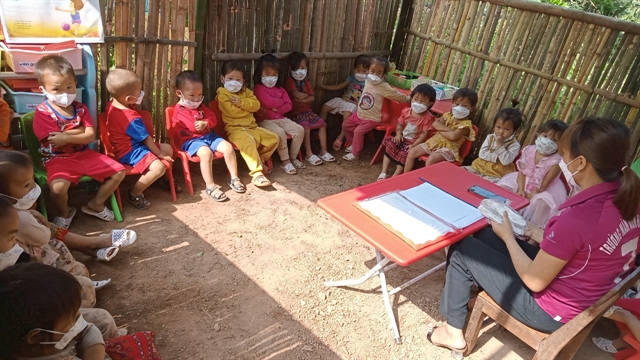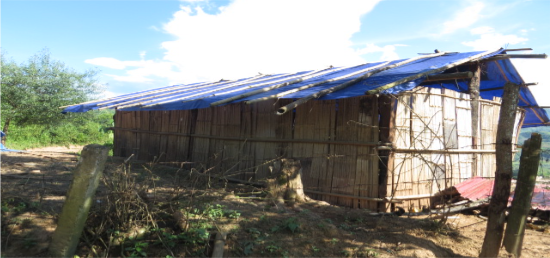 Society
Society

 |
| Children study in a temporary classroom in Mường Nhé District before their new classrooms are ready. Photo courtesy of the district's Division of Education and Training |
Minh Dũng
Hồ Thị Thắm, a teacher in Điện Biên Province, would never forget the night when she was stuck at Nậm Là Village’s school due to heavy rain and floods 17 years ago.
“There was no electricity, no food and no light. Just heavy rain. The strong wind tore off the school's tarpaulin rook, making me and my colleagues drenched all night and unable to sleep,” she said.
Seventeen years on, the sight of makeshift and precarious classrooms remains all too common in several hilly provinces of Việt Nam, not least in Điện Biên Province, positioned at the nation's extreme west.
Despite concerted governmental endeavours and generous contributions from benefactors, pupils within these regions persist in pursuing their studies in dilapidated educational facilities, bereft of adequate scholastic resources. This paucity of provision is a significant factor in the alarming rate of student attrition in these localities and poses a formidable deterrent to educators considering a posting in such regions.
For teachers such as Thắm, the mission to deliver the gift of literacy to their charges necessitates navigating a path laden with manifold challenges.
“I must have a predestined relationship with the job to be with this place for more than 17 years,” Thắm said.
According to statistics from Mường Nhé District’s Division of Education and Training, the number of underqualified rooms for students and teachers is still high.
More than 40 per cent of all classrooms in the district are semi-permanent, which are classified as those built of brick or wood with corrugated iron or tile roofs, but the quality is not as good as the durable rooms.
Over 67 per cent of other facilities (including teachers' rooms, medical rooms, auxiliary works, kitchens and canteens) are either semi-permanent or temporary. Temporary works are made of simple materials such as houses with walls of coconut leaves, thatched leaves and earth; roofs made of coconut leaves and bamboo.
Compared with the actual need to replace and supplement, Mường Nhé District still lacks 245 structures/rooms.
According to Phạm Thiết Chùy, Head of the district’s Division of Education and Training, one of the reasons for the deterioration of schools and facilities in preschool educational institutions is that they have been built for a long time and have expired.
The second reason comes from the geographical characteristics of the district, he said.
Mường Nhé is a district located in the mountainous border area that experiences very harsh weather, especially in the rainy season, Chuỳ said.
 |
| Nậm Là Kindergarten before being rebuilt. Photo courtesy of the district's Division of Education and Training |
The geology in some schools is also poor, leading to serious subsidence and mould seepage.
“This leads to a very rapid deterioration of facilities and there is even a high risk of affecting life and property,” the official said.
There are still many difficulties and shortages in facilities at preschool units in Mường Nhé District compared to the national average, he said.
Pre-schools in Mường Nhé District that have degraded facilities and need to be upgraded are located mainly in disadvantaged communes such as Pá Mỳ and Huổi Lếch.
These communes are inaccessible by car, so the transportation of construction materials faces many difficulties, and the transportation costs are also very high. Therefore, despite receiving the support of voluntary organisations and individuals, it is still almost impossible to build and renovate schools here, Chuỳ said.
Inadequate infrastructure has had negative impacts on the learning and teaching experience of students and teachers here.
“The area of each kindergarten’s campus is still limited. Facilities are old or broken. All have a great influence on the child care and education process,” Thắm said.
“The lack of physical facilities greatly affects the teaching and learning work of teachers as well as students. The lack of classrooms or related work makes students have to live in a crowded and overcrowded environment,” Chuỳ said.
Currently, some kindergartens operate as part-boards due to the lack of bedrooms and cafeterias, so both teachers and students have to make use of the classroom space to make a common living space.
Mường Nhé District has cooperated with local authorities and mobilised resources from the private sector and social organisations to improve the quality of early childhood education. Eleven out of 12 preschools in the district have been renovated thanks to their support.
 |
| Children enjoy a rebuilt classroom in Nậm Là. VNA/VNS Photo |
Mường Nhé continues to mobilise social resources to build new and supplement necessary facilities for preschool education. District leaders, district People's Committee, and Division of Education and Training actively connect with donor units to call for funding. The district has also set up a website: diemcuctay.dienbien.gov.vn to promote the image and information of Mường Nhé District. Thereby attracting more benefactors and sponsors to become more interested in their area.
In addition to the state's investment and support resources, the Division of Education and Training of Mường Nhé District has a plan for immediate solutions to overcome existing difficulties. The Division of Education and Training will mobilise and propagate to local officials, teachers, parents, and students to contribute to repairing and renovating schools, and environmental landscapes. Thereby gradually increasing the percentage of solidified schools and classrooms and contributing to improving the quality of preschool education in the district.
“I myself also very much desire and hope to have specific and practical support resources for preschool teachers in Mường Nhé District to motivate them to work and leave with the profession,” Thắm said. — VNS




